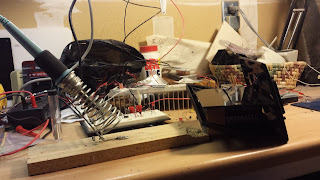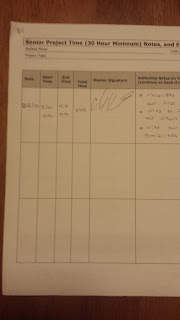For all you know, I could still be in the middle of drafting the machine itself, but I have the finished system sitting in a box on my shelf right now. What happened immediately after the last post is the construction and completion of the circuit box and the physical system, as well as creating and completing a working circuit.
After drafting the different designs, we went with the "spike" one (you can see the drafts in the last post). We measured and cut the spike from some aluminum and made it large enough to fit the circuit box, then we drilled holes through both the spike and the box so they could attach to each other. After that, we placed some rubber stoppers between the plate and the circuit box so we could place the wiring through the holes and have some wiggle room.
Below are three profiled photos of the design we went with:
1.) The Spike lying on its side. The point closest to us is where it sticks into the ground.
2.) This shot is at the same angle as before, but the heat sink is holding the Spike up.
3.) This captures the shape of the Spike. It's more of a wedge, really. This is what it would look like from the front once it was placed in the ground.
After attaching the box to the Spike, we worked on our circuit. The first image is of our original circuit, before we made it smaller. We drew this one and cut pieces out or shortened everything. We went through seven versions of drafts before we were able to make the circuit as tidy and tiny as possible. The second photo is the breadboard lying inside the circuit box after we screwed it in. The one after that is our final circuit, laid out inside the box.
Our thermistor ready for being attached to the circuit.
The peltier cooler and its collection rods, also ready to be attached.
After the circuitry was in place, Mr. Kennemore lent me his multimeter and I placed the Spike in my front yard, where the solar panel would be able to get as much sunlight as possible during the day, then the system would run at night. I attached the multimeter in series with the Spike system so I could just turn it on to get an amperage reading.
The mound of plastic has the multimeter wrapped in it as a safeguard against water. It's also holding the open connections between the multimeter, solar panel and Spike to keep them from shorting.
I set the Spike outside for five days (Monday through Friday night) and collected readings from the multimeter each night. At first, the collection rods were full of water, but as the week wore on there was noticeably less. Friday's rods had very little water. A common theme throughout the week, though, was that none of the water ever made it into the cup below. We figured that the water couldn't break its own surface tension and was evaporating while it clung to the rods.
Early week rods.
Friday night's rods.
Mr. Kennemore offered some ideas for modifying the Spike, which I added the next day. One was to tip the Spike by placing it in the ground on an angle. The other was to add a small piece if metal just under the rods, so that any water hanging down would touch the metal and break its surface tension. Then the tilt in the Spike would allow the water to run down the metal and into the cup below.
However, these modifications still didn't yield the expected result. The entire time the Spike was out, it was only drawing 30 mA on average, when the number was supposed to be around 600 mA. We replaced the batteries in the solar panel with fully charged ones and put it out again, letting the system run through one day and one night. When I checked, there was a substantial amount of water there, and some even made it down into the cup. Most of it was busy making its way down the metal and into the cup. The only problem was that the multimeter still read 40 mA. Obviously there are still some bugs, but the system worked the way we wanted it to.



































